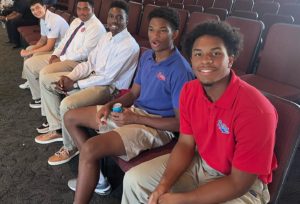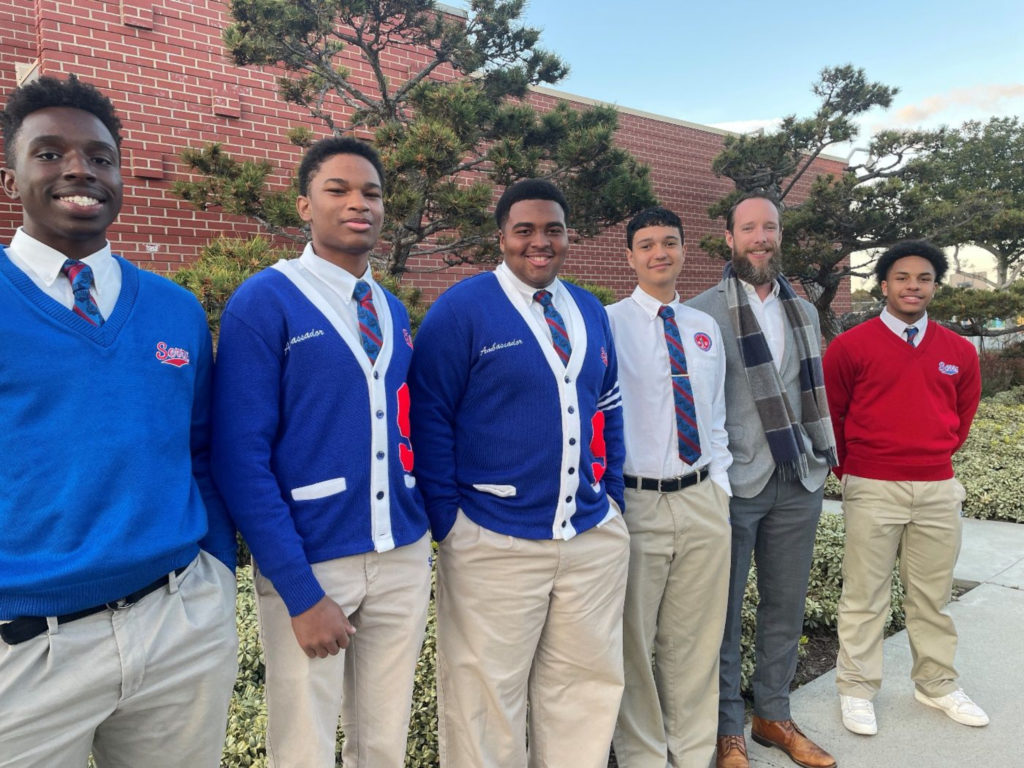On the night of Aug. 1, Christopher Holbert did something unusual.
To the sound of crickets, he put a blanket down in his backyard in Torrance, laid on his back, and gazed at the sky.
“Thankfully no one peeked over the fence,” Holbert said with a laugh.
Henry Toler, Holbert’s fellow senior at Junipero Serra High School in Gardena, also started exhibiting uncharacteristic behavior beginning Aug. 1.
“Every night,” said Toler of Carson, “I sat on the roof and just looked up.”
Holbert and Toler hadn’t suddenly become UFO nuts.
Rather, they and three other Serra seniors — Anderson Pecot, Travis Leonard, and Isaiah Dunn — were focused on the skies because a science project they worked on for months had been launched Aug. 1 on a SpaceX rocket as part of NASA’s “International Space Station Program.” Serra was one of nine high schools nationwide picked to participate in the elite student initiative.
Growing a seed in space
The program began last year when they were juniors. After weeks of the students tossing around ideas, they settled on “Automated Germination of Wisconsin Fast Plants in Microgravity.”
The experiment? Trying to get a seed to germinate and grow, potentially for food, plants and medicine in space.
For the month of August, astronauts aboard the International Space Station monitored the students’ experiment and downloaded data to them weekly. Students won’t get the full results of their experiment until the astronauts return, but the belief is the seed in space will grow at a rate comparable to the rate in a parallel experiment on Earth — if the seed receives enough water.
Getting a seed to grow in space requires a pump, water, fans, wicking materials, LED grow lights, and a nutrient solution.
The pump delivers water to the seed, which is covered in a wicking material — an absorbent cloth — for the seed to consistently receive water.
Fans move oxygen and carbon dioxide around the chamber, and light is needed for taking photos and growing the plant.
By using grow lights, the plant would be able to carry out photosynthesis and flourish once germinated — or so the theory goes. Things are different in space.
The students used a variety of the Wisconsin Fast Plant due to it being able to grow in the timeframe of the experiment.
So, what’s the point of trying to grow a seed in space?
Plants and food would be necessary for potentially living in space, as well for medicinal use for the potential treatment of diseases. The experiment also may help design systems for removing carbon dioxide from a sealed environment while contributing oxygen back to the surroundings, which could be helpful in long-term space flight and living situations.
Finally, the experiment also could yield information that could contribute to the development of agricultural systems on Earth.

Preparing for liftoff
Kenneth Irvine, science teacher and Science Department chair at Serra, worked closely with the students during their junior year to ensure the project would, well, get off the ground.
Many students who initially got involved in the project were members of the chapter of the National Society of Black Engineers (NSBE) that had just opened at the school.
But juggling athletics, classes, and other demands of high school isn’t easy. Holbert, Toler, Pecot, Leonard, and Dunn were the only remaining students to see the project to its completion.
“It was a process, with deadline after deadline,” Irvine said. “We had two to three weeks to come up with the experiment. At first, it kind of felt like ‘Looney Tunes,’ where the train is going off the cliff and they’re still laying down the track below.”
Pecot, who handled many of the electrical duties involved in the experiment, said he thought the project — conducted in collaboration with the Quest Institute, an educational nonprofit organization that develops and markets STEM educational programs and materials for K-12 schools — was far-fetched when he first heard about it.
“When people say they want to grow up and be an astronaut, that’s far in the future,” Pecot said. “To be able to be doing this in high school didn’t seem possible. But this experience has been amazing.”
Meanwhile, on Earth
As the students await word on how their experiment went, they recall a process that was a lot of work — they each toiled on it a total of about 120 hours — but very rewarding.
“It was definitely an experience,” said Toler, who with Leonard handled the mechanical engineering aspect of the project. Dunn was the software engineer and Holbert also tackled electrical and mechanical engineering duties. “We all have a lot of other things going on as high school students. Being able to do this shows our dedication, grit, and motivation.”
The ISSP program also sent the students to the USC Viterbi School of Engineering to stoke their interest in engineering.
“During their visit, the students participated in a Broader Impact workshop, which is part of a multi-university (National Science Foundation) superconducting workshop that USC Viterbi is a part of,” said Darin Gray, Ed.D., co-director of the USC Viterbi K-12 STEM Center, which hosted the students.
During the visit, the students conceptualized the societal impacts of their research and toured the school’s innovative Baum Family Maker Space.
Irvine said that in addition to his students, the experience was rewarding for him, too.
“My biggest goal was teaching the team the skills and how to use the tools, without giving them the answer to the problems they were trying to solve,” he said. “And they all did an excellent job.”

